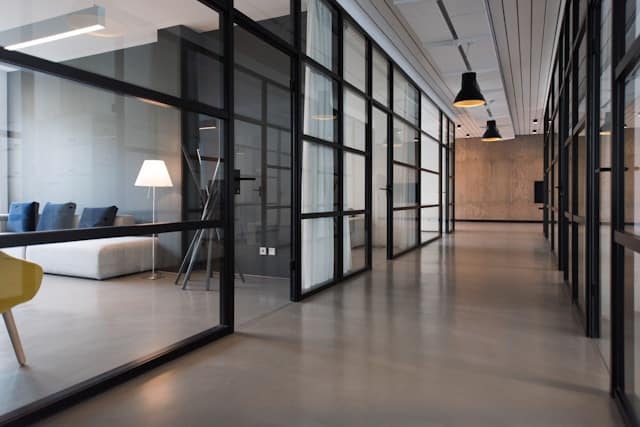How to Implement Biophilic Design Principles in Office Spaces for Enhanced Employee Well-being?

Biophilic design is a concept that is rapidly gaining traction in the world of architecture and interior design. This design philosophy involves incorporating natural elements into built environments. In an office environment, biophilic design can lead to several benefits. It can increase employee productivity, boost morale, and even improve health. This article explores how you can create biophilic office spaces that foster a healthy and inspiring environment for your employees.
The Concept of Biophilic Office Design
Biophilic design is an architectural trend that aims to integrate nature into built environments. The goal is to create a human-centered approach that improves health, emotional well-being, and productivity. In an office setting, this means designing workspaces that align with the human need for nature’s elements, such as light, air, and plants.
A lire en complément : How to Use Geospatial Data Analytics for Identifying Optimal Real Estate Investment Locations?
The key to successful biophilic design is more than just incorporating plants into the workplace. It involves creating spaces that allow employees to feel connected to nature. This can be achieved through various design elements, such as natural lighting, views of nature, natural textures and materials, and indoor vegetation. The biophilic office design is a conscious effort to bring the outside in, and in doing so, create a healthier and more productive work environment.
The Role of Natural Light in Biophilic Design
Light is one of the most crucial elements of biophilic design. In an office environment, natural light can significantly enhance employee well-being and productivity. Studies have shown that exposure to natural light can improve mood, reduce stress, and enhance sleep quality. Moreover, natural light in the workplace can reduce energy costs.
A voir aussi : What Are the Considerations for Building Eco-Friendly Commercial Properties in London?
You can incorporate natural light into your office design by maximizing the use of windows, skylights, and glass walls. If these options are not feasible, consider installing light fixtures that mimic daylight. It’s also beneficial to arrange workspaces near windows so employees can benefit from daylight and views of nature.
Enhancing Air Quality Through Plants
Plants play a significant role in biophilic design. Not only do they add aesthetic appeal to office spaces, but they also improve air quality and create a more relaxing environment. Plants act as natural air purifiers, removing toxins from the air and releasing oxygen.
You can incorporate plants into your office design in numerous ways. Consider creating living walls, which are vertical gardens that can be mounted on any wall surface. You can also place potted plants around the office, or use hanging plants to add greenery without taking up floor space.
To maximize the air-purifying benefits of plants, choose species known for their air-cleaning abilities, such as snake plants, spider plants, or peace lilies. These plants are also low-maintenance, making them perfect for office environments.
Creating Spaces for Interaction with Nature
Creating spaces for interaction with nature is another crucial aspect of biophilic design. These spaces provide employees with a place to relax, rejuvenate, and connect with nature. This could be as simple as an outdoor terrace or garden that employees can use during breaks.
If outdoor space isn’t available, consider creating indoor spaces that mimic outdoor environments. This could include indoor gardens, water features, or even nature-inspired artwork. These elements can provide visual stimulation and a sense of calm in an otherwise busy office environment.
Using Natural Materials and Textures
Lastly, using natural materials and textures is a powerful way to create a biophilic office environment. These elements can further enhance the connection to nature and create a more welcoming and relaxing space.
Consider using materials such as wood, stone, or cork in your office design. These materials not only add a touch of nature but also have excellent acoustic properties, helping to reduce noise levels in the office. You can use these materials in various ways, such as for flooring, wall coverings, or furniture.
Incorporating textures inspired by nature, such as leaves, bark, or water, can also help to create a sense of tranquillity and connection to the natural world. These textures can be introduced through wallpaper, upholstery, or decorative elements.
In conclusion, implementing biophilic design principles in your office can create a workspace that promotes employee well-being and productivity. By incorporating elements such as natural light, plants, interactive spaces, and natural materials, you can create an office environment that not only looks great but also has a positive impact on your employees’ health and happiness.
Acoustic Comfort and Biophilic Design
Acoustic comfort is a critical aspect of employee well-being that is often overlooked in office design. Biophilic design principles can be applied to address this issue in various ways. For instance, natural materials like wood and cork are commonly used in biophilic design, and they also happen to have excellent sound-absorbing properties.
Moreover, the strategic placement of water features and living walls in the office can also contribute to a more tranquil auditory environment. The sound of trickling water or rustling leaves can mask distracting noises, creating a more soothing work environment.
Another way to introduce natural sounds into the office is through soundscaping. This can include recorded sounds of nature, such as birdsong or waves, which can be played subtly in the background to enhance the connection to nature and promote relaxation.
Implementing biophilic design principles in office design can significantly improve acoustic comfort, contributing to an overall sense of well-being among employees. It helps create a holistic sensory experience that goes beyond aesthetics to directly impact mental health and productivity.
The Impact of Biophilic Design on Employee Well-being and Productivity
Evidence suggests that exposure to nature and natural elements can lead to a wide range of health and well-being benefits. In a workplace context, these benefits extend to increased productivity, reduced stress, improved mental health, and overall greater employee satisfaction.
A study by the Human Spaces Report found that employees working in environments with natural elements reported a 15% higher level of well-being and a 6% higher productivity level. Additionally, a study by the University of Exeter found that plants in the office could increase productivity by 15%.
By incorporating biophilic design in the workplace, you are not merely creating a visually appealing environment, but also a space that is conducive to mental and physical health. A biophilic office has the potential to contribute to a more positive work culture and improved business outcomes.
Conclusion
To sum it up, biophilic design is a powerful tool that can transform workplaces into environments that promote employee well-being and productivity. More than just a design trend, it is a human-centric approach that brings the nurturing aspects of nature into the built environment.
In the face of the increasing mental health challenges in today’s fast-paced corporate world, the need for such nature-inspired spaces is more critical than ever. By integrating elements like natural light, indoor plants, living walls, natural materials, and acoustic comfort, you can create a work environment that not only enhances employee well-being but also contributes to a sustainable future.
Remember, biophilic design is not about creating a jungle in the office. It’s about subtly weaving nature into the design to cultivate a deeper connection to nature. The benefits of this design philosophy extend beyond the individual to the organization and, ultimately, to the broader ecosystem. So when planning your next office redesign, consider the powerful impact of biophilic design principles.
